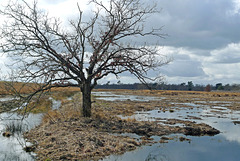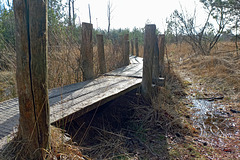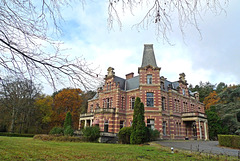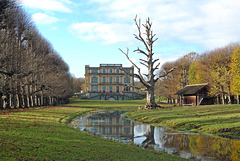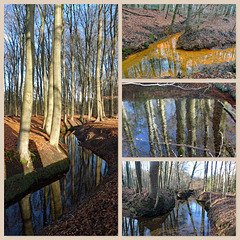Jaap van 't Veen's photos
Nederland - Blokzijl
| |
|
|
|
Blokzijl was mentioned for the first time in 1524 and in 1561 the village became the right as receiver of the toll by Spanish king Philip II of Spain. At the end of the 16th century Blokzijl became more and more an important trading post for peat, which was won in the hinterland and provided a lot of activity.
After the Siege of Steenwijk (1580-1581) during the Eighty Years’ War, a fortified lock (in local dialect called zijl or siel ) was built and the town was walled, creating a base for the war fleet and a base for operations for the Dutch troops against the Spaniards. The name Blokzijl - meaning fortified lock - originates from that time.
In the 17th century industry developed on and on in the form of breweries shipyards and other craft sectors. For some years Blokzijl even became city rights. The monumental houses with stepped gables date from that time.
Blokzijl is a small town with great charm due to the narrow streets, patrician houses, many picturesque corners and its beautiful harbour basin. Until 1973 it was a separate municipality, but nowadays is part of Steenwijkerland.
Nederland - Kloosterhaar, Engbertsdijksvenen
| |
|
|
|
The Engbertsdijksvenen owes its name to the Engberts farming family. The area used to consist of a four to seven meter thick layer of peat that was formed around 10,000 years ago. The original peat bog was about 180,000 hectares in size. Peat extraction started relatively late and was a small-scale operation until the 19th century. Farmers used the peat for their own needs, for instance to stoke their stoves. At the beginning of the 20th century, the peat extraction of the Engbertsdijksvenen was done on a large scale and lasted until the middle of the last century.
From 1953, Staatsbosbeheer (a Dutch government organization for forestry and the management of nature reserves) bought land in the Engbertsdijksvenen . Peat was last excavated in 1984. The area covers an area of 1,000 ha. A small core of peat of about 17 ha still has its original thickness. Only 25 hectares of "living" raised bog remain in the Netherlands.
The Engbertsdijksvenen has been given a protected status in several respects. The Staatsnatuurmonument (National natural monument) has also been designated a Natura 2000 area. It is therefore part of a European network of high-quality nature reserves. It is an international wetland and the largest and most important raised bog area in Western Europe.
Nederland - Noordoostpolder, Schokland - Waterstaa…
| |
|
|
|
Schokland - the first UNESCO world heritage site in the Netherlands - is an island in the polder landscape of the Noordoostpolder. The island is 4 kilometres long and 300-500 metres wide.
In the past Schokland was located in the middle of the former Zuiderzee, which washed away large parts of the island during storms. People lived there - from prehistoric times and the Middle Ages until modern times - in spite of the threatening water and the poverty.
Until around 1450, Schokland was not, in fact, an island but a swampy peatland with a few dry hills here and there. The whole area around Schokland was probably prepared for agriculture even before the 14th century. When the rising water washed away large pieces of the peatland, it became a peninsula. Schokland only became a real island when the (former) Zuiderzee swallowed up the last piece.
People were already living on Schokland 12.000 years ago. They lived there as hunter-gatherers and fishermen. During the Middle Ages there were mainly farmers here who kept cattle and grew cereal crops. From the 12th century inhabitants lived on terpen (man-made mounds). At high tide or during a storm tide these hills were the only safe places on the island. During the 17th century, agriculture declined because of the loss of land to the sea. Trade, shipping and fishing became more and more important.
In 1859, the islanders lost their battle against the water for good. The Dutch government decided that the inhabitants had to leave the island. Not only because of the continuing danger of floods, but also because of the poverty. Around 635 Schokkers moved to the mainland. Schokland remained in existence, but in 1942 - following the reclamation of the Noordoostpolder - it became an island on dry land.
The Waterstaatskerk (also called Enserkerk ) was built in 1834 by the Directorate-General for Public Works and Water Management, as a replacement for a small square church that had stood on this site until that time. This square building was so badly damaged by a storm in 1825 that it had to be demolished. The church served until the evacuation of Schokland. After that, it was used as a warehouse and sleeping place for seasonal workers.
Nowadays this church - a national monument - is part of the Museum Schokland and is also used for weddings and classical concerts.
Nederland - Westerbork, Stefanuskerk
| |
|
|
|
The Stefanuskerk (Church of St. Stephen) is a Gothic church, which was built at the beginning of the 15th century as a Catholic church. The church was dedicated to the martyr Stephen, just like the mother church in Beilen. After the transfer of the church to the Protestant community around 1600, the name was somewhat forgotten. Since 2007, the church has officially been called Stefanuskerk again.
The tower of the Stefanuslerk was built earlier. The lower part of the tower is dating back to the 13th century. Later, in 1778, the upper part of the tower was built. The tower has three bells, one of an anonymus bellfounder from early 14th century.
The village church of Westerbork has existed for over 800 years. In an old document from 1206, the "capella te Burcht" was already mentioned. It was probably a small wooden chapel, covered with straw. This historical fact was the reason for the Westerbork community to celebrate the 800th anniversary of the village in 2006. Around 1360 the wooden chapel was replaced by a stone church, which was then somewhat smaller than the current church.
Nederland - Oude Niedorp, ruïnekerk
| |
|
|
|
The first stone church in Oude Niedorp was built on a mound around 1250. The church had to be demolished in the 14th century due to subsidence of the peat soil. The 'present' church was built against the tower, which had remained. The church was dedicated to St. Werenfridus until the time of the Reformation. At the end of the 15th century two naves were added to the ship, which were pulled down again in the 18th century. After the stone tower was demolished and rebuilt twice due to subsidence, a wooden tower was added to the church in 1814.
After restoration of the church in the 16th and 17th centuries, a last general restoration followed in 1953/54. On 3 April 1977, the church was destroyed by lightning. The walls - dating from the year 1648 - were retained, which the municipality - the current owner - is trying to preserve as a monument from the past after a renovation in 2011/2013.
The ruined church in Oude Niedorp is one of the four ruined churches in the Netherlands.
Nederland - Orvelte
| |
|
|
|
The village of Orvelte probably originated between the 11th and 13th century. In a charter from 1362 the village is referred to as “Oervelde”. This oldest notation indicates the origin of the place name: the village Over het veld (Across the field).
The village with its cobbled streets is made up of a collection of thatched Saxon farmhouses and other heritage buildings. The oldest farm in Central Drenthe - built between 1560 and 1650 - is also located in Orvelte after a relocation. The car-free village still exudes the atmosphere of a 19th century village in Drenthe. In 1967 Orvelte received the status of protected village-scape.
Nowadays Orvelte presents itself as a monument village. In addition to the normal daily activity and residential function, many of the farms are equipped to display old crafts and are used by shops, which mainly sell nostalgic and/or vintage items. There are also several small museums; one shows the period rooms of the family who lived there in the 19th century.
Nederland - Wilsum, Sint-Lambertuskerk
| |
|
|
|
With less than 900 inhabitants and approx. 350 houses, Wilsum still is a city. It was (probably) already granted city rights by the bishop of Utrecht in 1321. When you visit Wilsum nowadays, you cannot imagine that you are in a city. It looks more like a peaceful country village, nicely situated on the banks of the river IJssel.
The only building that reminds you of a town is the imposing Sint-Lambertuskerk (Saint Lambert Church), one of the oldest churches in the province of Overijssel. The church is dating back to the year of 1050, but nothing is known about the original structure. The tower with the nave is the oldest part: they are Romanesque in design and probably date from the 11th century.
The church has undergone several changes in its almost 1.000 years of existence. After the Reformation, the church was stripped of its Roman Catholic characteristics. Original there were five Romanesque windows on the north and south sides of the nave, while the east side and the choir were closed. The present Gothic choir was built in the 14th century, against the then lower nave of the church. Major changes were made to the nave in the 15th century. The side walls were raised and vaulted, while the Romanesque windows were replaced by pointed arch windows.
During a restoration in 1902, neo-Gothic influences gave the church its current character. During the last restoration of the Sint-Lambertuskerk in 1982 a number of wall paintings - hundreds of years old - were discovered.
Just hope Ipernity will survive !!
| |
|
|
|
This is the third time I have (re)posted this picture; always when the survival of Ipernity is at stake. After 2016 (takeover by IMA) and late 2020 (major technical problems) I feel the future is hanging by a thread again. If I read the team message from January 28. correctly, two crucial posts on the IMA board must be filled by 25 February.
Please read the last two Club News: www.ipernity.com/blog/team/4737428 and www.ipernity.com/blog/team/4738398
Again I keep my fingers crossed.
Chile - Easter Island - Ahu Tahai
Nederland - Mantingerzand
| |
|
|
|
Mantingerveld consists of four small nature reserves, which are reduced to one large continuous area through activities of Natuurmonumenten (a Dutch society for nature conservation). The original landscape of the province of Drenthe with heathland, raised moors and fens must be restored over time.
Mantingerzand - one of the four reserves - lies somewhat higher and that made it uneconomical to cultivate the area in the past centuries. On maps from the beginning of the 17th century, the area is already clearly distinguishable; it has hardly changed since then. Mantingerzand is an area with shifting sand hills with countless juniper bushes on it. The reserve with juniper berries was acquired by Natuurmonumenten in 1920; one of the first purchases of the organisation in the province of Drenthe.
On the edge of the reserve are numerous old crooked oaks, which held the drifting sand. The oldest tree in the Mantingerzand is a pine, which has probably been here since 1840.
Nederland - Dwingelderveld
| |
|
|
|
Nationaal Park Dwingelderveld is one of the about twenty national parks in the Netherlands and is the largest European wet heathland area. The national park - 3.700 hectares - has more than sixty fens - some of them date from the last Ice Age - and peat swamps featuring a rich and unique flora and fauna. Dwingelderveld is considered being one of the most beautiful national parks in the Netherlands.
This time we made a walk through the northern part of the Dwingelderveld . Initially through a forest that has been planted since 1925 and later along heathland and vast open swampy landscapes. What was noticeable was the very muddy state of the paths. After about four kilometers we reached the boardwalk, for which this route (marked with white arrows) is famous. This is a narrow - only three shelves wide – path, really necessary as you are walking above the water here. Although only a few hundred meters long, it was fascinating to do.
Dwingelderveld is managed by the Dutch forestry Commission ( Staatsbosbeheer ) and the private Dutch society for nature conservation Natuurmonumenten . Since 1991 it is a national park and in 2013 the park was added to the List of Nature 2000, as part of the European Network of most valuable nature reserves of Europe.
See for more pictures of Dwingelderveld : www.ipernity.com/doc/294067/46540292 and www.ipernity.com/doc/294067/46551468 .
Nederland - Kampen, d’Olde Zwarver
| |
|
|
|
In the 19th century eight windmills were active in Kampen. Flourmill d’Olde Zwarver is the only one left. The history of d 'Olde Zwarver is dating back to 1842, when its predecessor de Voorste Molen burnt down. In 1865 the mill was sold, yet difficult times for the mills were coming. Steam engines came up and mills were dependent on wind; secondly the urbanisation of Kampen with higher buildings took the wind away from the windmill. In 1913 a gas turbine was installed in d'Olde Zwarver and the mill remained in use till 1949.
In 1952 a new owner of the mill - a dairy factory - wanted to expand its factory and the mill had to be demolished. A huge protest arose from the inhabitants of Kampen. At that time the number of windmills in the Netherlands had been decreasing dramatically and this mill was the last one in Kampen. Due to the reactions, the factory handed over the mill to the municipality of Kampen. A new location was found at the Herkenhoofd , not far away from the original place and the idea arose to move the mill as a whole. This had not been done ever before. On April 7th, 1952, the mill was carried 550 meters by a huge truck with 48 wheels to its current location along the river IJssel. This spectacular relocation caused the name of the mill: d’Olde Zwarver (the Old Vagabond).
The mill was restored several times - the last time from 1999 till 2001 - but nowadays is still in operation. Since the 70s of last century millers voluntarily keep this "living" cultural heritage spinning and grinding.
Nederland - Zalk
| |
|
|
|
Zalk is a small rural village with less than 800 inhabitants, situated between the towns of Kampen and Zwolle along the river IJssel.
The village was part of the heerlijkheid (fiefdom) “Zalk en Veecaten”. After the creation of municipalities in 1813 the fiefdom was transformed to the municipality of “Zalk en Veecaten”. Nowadays Zalk belongs to the municipality of Kampen.
The most important building in the village is the Sint Nicolaaskerk (St. Nicholas Church) with a Romanesque tower dating back to 1220. In addition, the village has a flour mill dating back to 1860. Zalk became well-known in the Netherlands as the home of the kruidenvrouwtje Klazien ("herb woman klazien").
Nederland - Zalk, Sint Nicolaaskerk
| |
|
|
|
Sint Nicolaaskerk (St. Nicholas Church) is an old church whose Romanesque tower dates from 1220. The rest of the church was built in Gothic style against the existing tower around 1400, partly with material - mostly tuff - from a previous smaller church.
The church was founded by the Lords of Buckhorst who owned a castle in this area. This castle was demolished in 1841, but the church still contains, among other things, Buckhorst pews and a family tomb. The church was maintained by the descendants of the Buckhorst family until 1838.
Over the centuries, the church fell into disrepair. That is why work began on restoring the exterior of the church in 1991. Services are still held in the Sint Nicolaaskerk by the Reformed Congregation Zalk en Veecaten .
Nederland - Diever, hunebed D52
| |
|
|
|
Dolmen D52 - just outside the village of Diever - is a medium-sized dolmen. It has fourteen sidestones and two closing endstones. From the original seven capstones six are still present. One is missing and of the remaing six, three still supported on their sidestones, the other three having slipped between theirs.
Dolmen D52 is 14.5 meters long and 4.8 meters wide.
Dolmen D52 is already mentioned in the 17th century and is depicted on the French maps. At the time of a big survey by Prof. Van Giffen (1918) the dolmen was a total ruin. Under his supervision this hunebed has been thoroughly restored in 1953/54. In 1995 restoration works were still performed to this dolmen.
Nederland - Overveen, Duinlust
| |
|
|
|
Duinlust is one of the many so called buitenplaatsen (summer residences) west of the city of Haarlem along the inner dunes. Wealthy merchants from Amsterdam built here their mansions.
In 1783 a first house was built. After it was old in 1810 the new owner founded the Duinlust country estate and built a white house built in Empire style. There was also an orangerie, which still exists. In 1828 the house was sold again to Johanna Jacoba van de Velde, who also was the owner of the nearby Elswout ountry estate . After her death, the country estate goes to her son Willem Borski, a well-known Amsterdam banker. It became the summer residence of his eldest daughter Johanna Jacoba. After Willem Borski's death in 1881, she inherited the estate. Johanna Jacoba had a new house built by architect Constantijn Muysken in 1881. It is designed in neo-renaissance style.
During the World War II, Dutch troops were stationed there, later it was confiscated by the German occupiers. During the last weeks of the war it was used by Canadians and the Homeland Forces. The house was in poor condition and as of November 1, 1947, the government rented the country estate and restored Duinlust.
The CIOS (the first school for sports leaders) was located in the house from 1948 to 2001.
Nowadays the mansion is used for events. The surrounding park is a nature reserve managed by Staatsbosbeheer (a Dutch government organization for forestry and the management of nature reserves).
Nederland - Overveen, Elswout
| |
|
|
|
Dutch economy reached a peak in the Golden Age. To escape the foul stench of the city in the summer, wealthy Amsterdam merchants invested in luxurious country estates with park-like gardens in the forested inner dunes. Thanks to a system of barge-canals and rivers, they could travel from Amsterdam to their estates in just a few hours. The area west of Haarlem (Kennemerland) became the cradle of these country estates.
Buitenplaats (summer residence) Elswout was founded in the middle of the 17th century by Carel du Moulin, but the Amsterdammer Gabriel Marcelis completed the first construction of Elswout. Over the centuries, many great architects worked on the ever-changing architecture.
The oldest buildings on Elswout date from the 17th century. The construction of the Grote Huis (Big House) on the Elswout Estate already started in 1884. When the façades and the terraces were completed, the client Willem Borski jr. died and construction came to a standstill. Although the building was given various functions after his death, it remained unfinished.
After being occupied by the Germans during World War II the building was in bad shape. It later functioned for different purposes like schools. Elswout estate and the house became property of the municipality in 1958 and the Dutch State Forestry Commission in 1970. Over the years they could not find a proper function for the building and decided to have a competition for the rebuilding and renovation of the estates building. A private company decided to take up the challenge. After thorough search and research the original plans from around 1814 were found. Restoring the building’s interior and exterior according to those plans started in 2004 and realizing a new high end office function for the building.
Elswout also offers one of the most beautiful and watery country estates along the inner dune edge of Zuid-Kennemerland National Park. This 85-hectare national monument has a rich plant and animal life and is dotted with several special follies. Because of the special flora and fauna, Elswout (and the rest of National Park Zuid- Kennemerland) have a Natura 2000 status and the area is part of the European protected nature network.
The Elswout house has never been open to the public, so it can only be admired from the outside. The garden can be visited and access is free.
Nederland - Niersen, Motketel
| |
|
|
|
The Motketel is originally a wet area, where the groundwater level is close to the surface. The name probably refers to a low area with humus frequented by wild boar. A mot or motte is a female pig and a boar's daytime resting place and nest is called ketel .
Between 1600 and 1800, the high groundwater level was used to dig water wells here. The water from the more than 20 wells was discharged via man made brooks and streams to the village of Vaassen. Running water meant business and therefore income. With watermills, the water was used for washing, grinding, hammering and cutting.
In the 18th century, 17 watermills were operated, using the water from the Motketel springs. The watermills have almost all disappeared, but the Cannenburchermolen , near the castle of the same name, is still there.
The watercourses of the Motketel form the most intact and complex system, which is still visible in the landscape and is one of the most unique in the Netherlands. The system is opened up by a network of footpaths.
Nederland - Hoenderloo, plaggenhut
| |
|
|
|
Hoenderloo is a village, which only came into existence at the beginning of the 19th century on the rough lands of the Veluwe. In the spring, eekchillers went to this area to strip felled oak trees of their bark, which was used for tanning leather. The eekchillers lived with their families in temporary huts made of sods.
Heather mower and shepherd Albert Brinkenberg was the first permanent resident of Hoenderloo. He built a sod hut (a simple hut partially buried and with a roof covered with sods) between 1813 and 1815. After him, more colonists followed. The residents were poor and worked as forest laborers, sheep shepherds, and plowmen, among other things. Slowly but surely, a small colony of huts made of sods arose. It was called Hoenderloo, after the many korhoenders (black grouse) that roamed there.
The reconstructed cottage is really a stone's throw away from the hut that Brinkenberg built. The present wooden house (unfortunately not open to the public) gives some impression of how sober life must have been.
Jump to top
- ipernity © 2007-2024
- Help & Contact
|
Club news
|
About ipernity
|
History |
ipernity Club & Prices |
Guide of good conduct
Donate | Group guidelines | Privacy policy | Terms of use | Statutes | In memoria -
Facebook
Twitter


